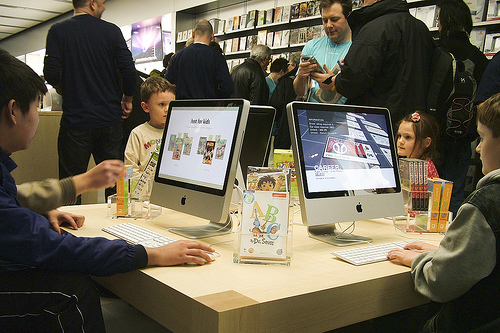First, relative to today, technology was expensive – in 2002, a laptop with 512MB RAM, a 30GB hard drive and 15” screen running Windows XP or Mac OS X, sporting a not-so-fast 802.11b Wi-Fi connection and modem, cost about $3,000. For the most part, with the exception of these heavy laptops and some not-so-smart phones, mobile technologies were relatively unfamiliar in education.
Internet infrastructure was also a challenge. If any Web connections were prevalent in schools, they were rarely wireless. It really hasn’t been so long since NetDay, a grassroots volunteer effort, physically wired 75,000 classrooms for Internet access in 40 states between 1996 and 2001.
Yet the old evaluation cycle would work, haltingly. Online classes and distance learning began in higher education, as did digital textbooks, before filtering though the adoption strata into K-12 education.
Other times a technology might stall or dead-end. While consumers were buying multimedia CD-ROMs for home educational use in the 1990s, for instance, schools were still investing in libraries of LaserDiscs.
But in the past handful of years, this traditional adoption cycle has been compressed – if not completely overturned.
SHRINKING TIME LAG
The iPad is just one example, as it moves from the consumer market to both higher education and K-12, not trickling through the former to reach the latter. A survey released in March by Harris Interactive and the Pearson Foundation found that 25% of college students own tablets (63% of those are iPads), tripling from 7% in a single year. At the same time, 17% of high school seniors own tablets, quadrupling from 4%.
Another instance: Online learning is bubbling back into consumer from higher ed. MITx, an online-only initiative of MIT open to learners outside of the physical campus, attracted 120,000 students to its first course this spring – and could lead to an optional, official certification of completion for many. Even K-12 participates in this blurring: interactive whiteboards, a staple of many school classrooms, have made inroads into colleges and universities with 38% of college students recently telling a Book Industry Study Group survey that they use them “to a large extent.”
On one hand, this decade-long lag allowed for thoughtful analysis, planning and observations of technologies that worked and were not just passing fads. On the other hand, it let educational institutions get horribly out of sync with the rest of students’ lives. But that time lapse has apparently become an adoption lag of two-to-three years. Or less.
A good chunk of the reason for the change is rational. Technology, now, is increasingly cheap. That $3,000 laptop is now about $500-700 – plus it’s far more powerful, and could be a netbook or a tablet with an optional keyboard. Upfront purchase instructional software is now supplemented or replaced entirely by individual apps, digital subscriptions or “free” Open Educational Resources.
And the required infrastructure has moved from wired and plugged to wireless, cloud-based and battery-operated, leapfrogging the earlier NetDay efforts.
But an equally large part of the reason for the acceleration may be both biological and psychological: Technology’s presence is familiar, almost expected, to accomplish a task. It’s not just students who are “digital natives” these days. No one under the age of 30 knew adolescence without a Web browser, let alone a personal computer (introduced, respectively, in 1993 and 1977). That means a lot of teachers, administrators and even education policy makers carry the same tech expectations as their students.

Flickr: OrangeFred
Finally, layer on three outside forces that are caffeinating the bees in this consumer/K-12/higher ed cross-pollination. Venture capitalists see K-12’s Common Core State Standards leveling the playing field by potentially lessening the cost for entrants to be “standards aligned,” and able to sell into one nearly 50-state market rather than up to 50 individual state-standard specific markets. Foundations consider tech a lever for education reform.
And don't forget there are the non-edu technologists, who see an unmet need and are being propelled into ed-tech through competitions such as Startup Weekend EDU, SXSWedu’s LAUNCHedu, and at three years old, the comparative granddaddy of such events, the Software and Information Industry Association’s Innovation Incubator.
What all these external efforts have in common is that they don’t necessarily respect the traditional separations between types of education markets. So what results is often a Dr. Doolittle pushmi-pullyu-esque mashup of ideas that could play in one or more of K-12, higher education, continuing/professional education, lifelong education and direct-to-parent. All of which will cause the walls to crumble even more.
Project Tomorrow, in last year’s Speak Up National Research Project report, summed up a key facet of the change: “Today’s students are functioning as a Digital Advance Team for the rest of us, scouting out these new technologies, adopting them for use in their personal lives and then effectively adapting them for education purpose….”
Except now, those digital scouts could be anyone who brings an outside device or app into a school or college.
The result? Something different, fluid, with less domain separation and more immediate influence. Altogether, it likely represents an unprecedented convergence of K-12, higher education and consumer technology – or a collision, one in which no tech, person or preconceived notion is just an innocent bystander.



